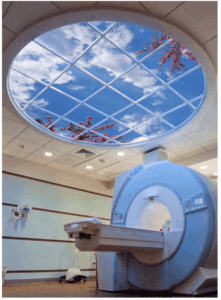
The poor MRI. It is an undeserving recipient of a bad rap caused by misinformation, rumor, or in many cases, downright ignorance. Some say all the negative press was started by an insecure X-ray department. Others say it was the exploratory surgery industry that was put out of business by modern imaging. Even the true name of the MRI process — nuclear magnetic resonance — is not used in the public domain because of negative connotations related to the word nuclear. The public does not want to be near anything nuclear.
Reports of the MRI making insufferable noise, causing overwhelming claustrophobia, and taking excruciatingly long, have given MRI first timers something to stress about for hours or even days before their visit (needlessly of course). Unfortunately, these unwarranted fears are often intensified when the patient first enters the MRI suite.
One way to mitigate the negative effects of high-tech healthcare environments is through the use of a window or skylight that will naturally provide a sense of time and place with a direct connection to the outside world. However, real windows and skylights are quite an engineering and financial challenge for an MRI suite.
An effective option is scientifically based virtual skylights designed and engineered expressly to mitigate the isolation in modern healthcare diagnostic rooms. Knowledgeable, Biophilia-based photographic artists team with brilliant, like-minded technical wizards to provide image reproductions with unsurpassed realistic clarity and depth. The images are supported in MRI-compatible LED lighting systems that can operate maintenance-free for decades. The combined disciplines of art and technology are able to communicate depth, volume and texture, guiding the viewer’s eye through drastically credible overhead skies.
Virtual skylights created and implemented correctly can generate a strong visual illusion that will not only help the patient entering the MRI suite, but also provide residual benefits while he or she is undergoing the test, even when out of view of the skylight. Once the patient is aware that the skylight is there, the indirect benefits continue. Equally important is the staff that endures a room visually isolated from the outside world all day. They benefit directly and continuously from this exposure to the sky as well.
For departments planning major renovations or new construction, it’s a good idea to research the options available for providing Biophilic Engagement through a visual connection with the outside. Architecturally there is reliable, contemporary research by experts such as Ulrich, Kellert, Heerwegen, and Witherspoon (just to name a few), that supports the benefits of creating Biophilic Engagement through a visual connection with nature, the sky and the outdoors in general. Research shows the measurable, positive results it has on occupants of today’s healthcare environments.
It’s not art, it’s the sky. And everybody loves the sky.